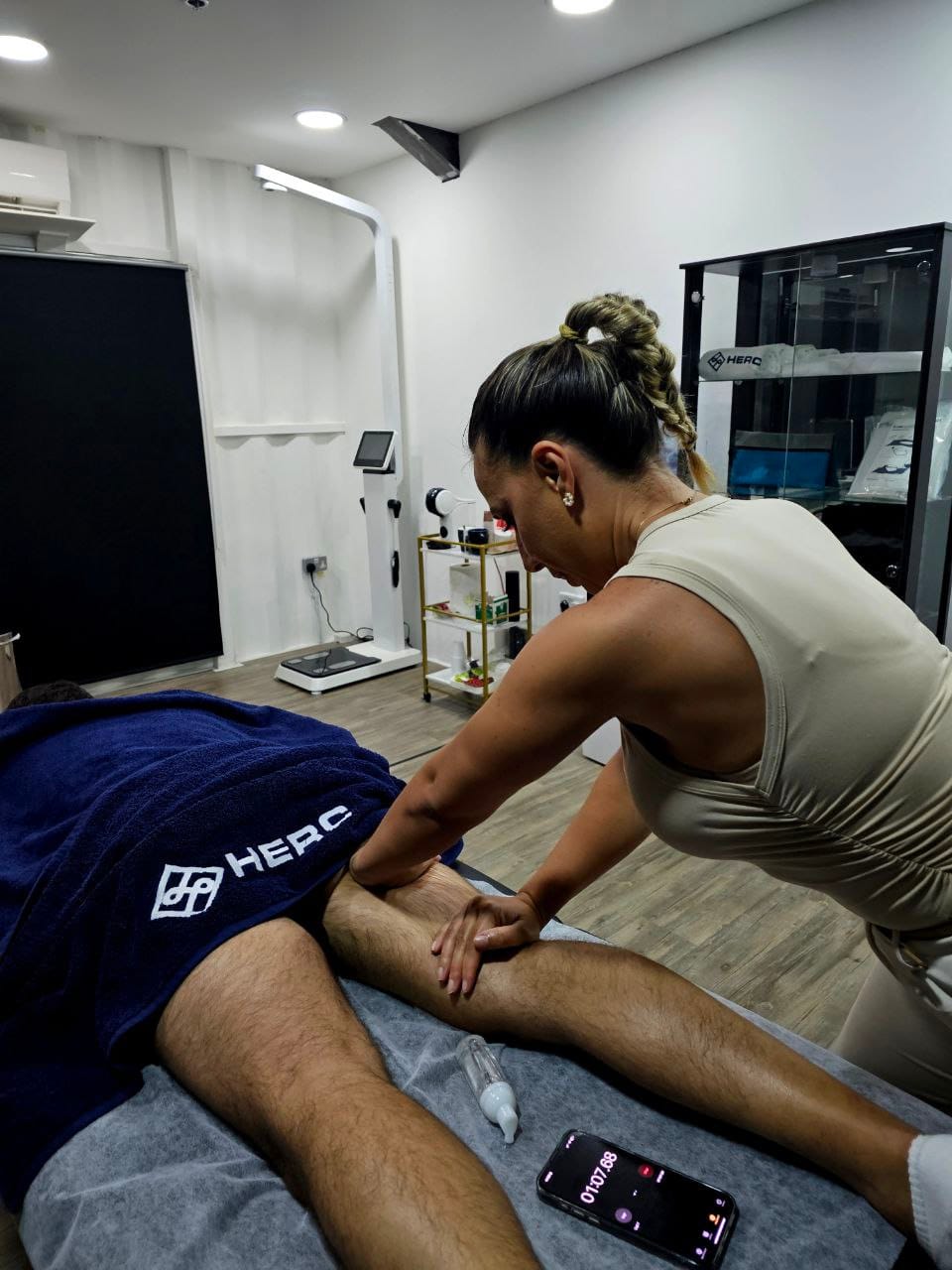
Acute Effects of Sports Massage on Lower Extremity Range of Motion in
Physically Active Adults: Controlled Pre-Post Intervention Trial
Authors
Ivana Banićević 1, Željko Banićević 1,Žiga Kozinc 2, Amadej Jelen 2
1 HERC – Health, Exercise & Research Center, Dubai, UAE.
2 Faculty of Health Sciences, University of Primorska, SI-6310 Izola, Slovenia.
Phase
Data collection.
The Project
BACKGROUND:
Sports massage is widely used by physically active individuals and athletes to prepare for training and competition, with the aim of improving flexibility, comfort, and perceived readiness. Although several studies suggest small, acute increases in range of motion (ROM) following massage, findings are mixed and often limited by eterogeneous protocols, non-standardized measurements, or small samples.
There is a need for tightly controlled, instrumented assessments that isolate the immediate effects of a standardized sports massage protocol on lower extremity flexibility, particularly hamstring extensibility, in a physically active population.
OBJECTIVE:
Primary objective:
Quantify the acute effect of a single, standardized sports massage session onlower extremity ROM in physically active adults.
Specific aims and hypotheses:
Hypothesis 1 (General improvement):
Sports massage therapy will acutely increase lower extremity ROM.
Hypothesis 2 (Specific joint improvement):
A single session will significantly enhance hip flexion and hamstring flexibility (assessed by knee extension ) immediately post-intervention.
Hypothesis 3 (Comparison to baseline):
ROM will show a statistically significant acute improvement post-massage compared to pre-massage baseline.
Exploratory aims:
Examine whether baseline ROM predicts the magnitude of change; capture subjective comfort, perceived effectiveness, and preference.
DESIGN:
Study design:
Randomized, within-subject crossover, pre–post intervention trial. Each participant serves as their own control.
Participants:
20–30 physically active adults, balanced by sex.
Inclusion:
Physically active; no recent injuries to the lower limb.
Exclusion:
Neuromuscular or joint disorders; current pain.
Procedures:
Each participant completes two sessions separated by a 6-day washout.
Session types include the sports massage condition and a time-matched comparator condition; session order is randomized. This enables time × condition comparisons while controlling for individual variability. In each session, ROM is measured immediately before and immediately after the session.
Measurement and analysis:
ROM assessed with validated goniometric techniques using the VALD DynaMo, with standardized joint positioning and stabilization.
Test–retest reliability of baseline measures will be evaluated by comparing pre-session values across sessions.
Primary analysis:
Repeated measures ANOVA or linear mixed models (time × condition), with effect sizes (Cohen’s d) and 95% confidence intervals for pre–post changes.
Optional metrics:
Percent change in ROM; correlation between baseline ROM and magnitude of change.
SETTING:
The study will be conducted in our research department’s human performance laboratory, a controlled clinical environment equipped for standardized ROM assessment and delivery of manual therapy by licensed practitioners.
INTERVENTION:
Sports massage:
A single, 5-minute, standardized pre-activity sports massage focusing on the hamstrings (matched for time and muscle group), delivered by a licensed and experienced sports massage therapist.
Protocol:
Standardized stroke order and tempo appropriate for pre-competition/training preparation (not recovery-focused). Intervention delivery and adherence will be logged.
Comparator:
A time-matched, non-massage condition to isolate the specific effects of sports massage. Order of conditions is randomized, with a 6-day washout between sessions.
OUTCOME MEASURES:
Primary outcomes:
Straight Leg Raise (SLR) test ROM.
Hamstring flexibility via knee extension.
Timing:
Assessed immediately before and immediately after each session.
Tools and procedures:
VALD DynaMo for angle measurement, using validated goniometric
techniques and standardized positioning/stabilization to ensure consistency.
Secondary outcomes:
Subjective comfort, perceived effectiveness, and preference questionnaires collected post-session.
Optional:
Percent change in ROM; correlation between baseline ROM and magnitude of change.
Reliability:
Test–retest of pre-session baselines across conditions.
SIGNIFICANCE OF STUDY:
This project addresses a practical question for athletes, coaches, and clinicians: does a brief, standardized sports massage meaningfully and immediately improve lower extremity flexibility? By using a randomized within-subject crossover design, rigorous standardization, and objective instrumented ROM assessments, the study will provide precise estimates of the acute effects of sports massage and their variability.
Results will:
Clarify the short-term impact of pre-activity sports massage on hamstring extensibility and hip flexion.
Inform evidence-based pre-training and pre-competition routines.
Identify whether baseline flexibility moderates responsiveness to massage, guiding individualized recommendations.
Contribute effect size estimates and confidence intervals to the literature, helping to power future trials and refine manual therapy protocols.
If sports massage demonstrates clinically meaningful acute gains in ROM under controlled conditions, the findings can support targeted use in warm-up strategies. If effects are minimal or limited to certain subgroups, the study will still provide valuable guidance for optimizing preparation practices and directing future research.
